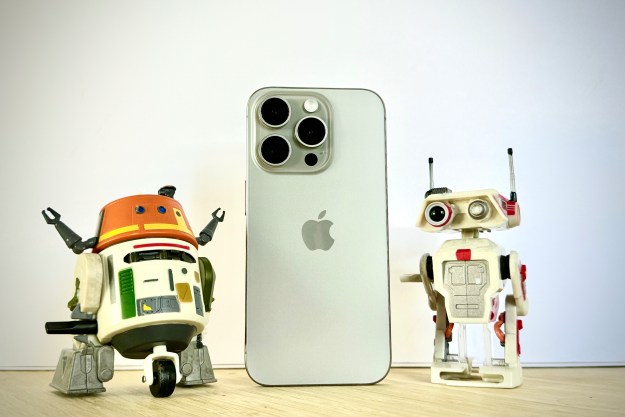The Planet Computers Gemini, a 90’s personal digital assistant (PDA) transported into 2018, is a product overflowing with quirk, which means its niche appeal is strong. But everyone else looks at it with a sideways glance and little more. To satisfy those who actually want to use a PDA-style device today, the company has now made the Cosmo Communicator, which it says is the flagship device in its range. The new Cosmo retains the PDA design of the Gemini, but adds in features most modern smartphone users consider essential. We got a look at a prototype during CES 2019; not enough for a hands-on, but we left with some impressions.
External screen
On the Gemini you had to open the clamshell body to do anything, as the screen and keyboard were inside. For the Cosmo, a screen has been added on the outside of the device, so you can interact with the phone without opening it up. The external screen measures approximately 2 inches, joining the 6-inch screen inside. You can answer calls, add quick replies to messages, and scroll through notifications on the external screen, without needing to open the clamshell.

This new design is welcome improvement, as it makes the Cosmo function more efficiently. However, we weren’t given the opportunity to play with it, as we only saw a prototype with the screen running a basic demo mode. It looked slick and smooth, and it was certainly very bright, but we couldn’t test responsiveness or how it felt to interact with a small screen on a very large device.
Yes, the Cosmo is big — it’s the nature of the beast, after all. It’s longer than an iPhone XS Max, and twice as thick. It weighs 300 grams (0.66 pounds), which is heavy . It is “pocketable,” in that it’s still a mobile device, but the bulge it creates in any trouser pocket will border on the unsightly. This won’t really matter to those seriously considering the Cosmo, as this is a productivity device and it’s the keyboard inside that’s the big selling point.
New keyboard and camera
The Cosmo’s keyboard has been updated and refined over the Gemini’s. Typing experience has been improved, according to the company, which we hope means the typing issues we encountered on the Gemini have been fixed. Even better is the Cosmo’s keyboard will have a backlight for working in the dark, and little feet will be added to the unit’s bottom to make it more stable on a desktop. Like the external screen, we only saw a second prototype without a finished version of the new keyboard, so could not test the improvements in person.

Another new feature on the Cosmo is another we couldn’t try out, but is again a welcome addition: a camera. The Gemini doesn’t have one built in, and required you to buy a special module. The Cosmo’s 24-megapixel camera sits above the external screen, and there is also a 5-megapixel selfie camera inside the device.
Below the external screen is a fingerprint sensor that doubles as a smart key for accepting or declining calls.
More CES 2019 coverage
- TCL is set to innovate with new mobile display technology
- Samsung uses CES to confirm that foldable phone is coming in 2019
- T-Mobile completes the first 5G data and video call using 600MHz spectrum
Planet has gone for another MediaTek processor for the Cosmo, but this time has opted for the new Helio P70, which is good news. This is one of MediaTek’s new-generation chips with decent artificial intelligence enhancements, and other abilities more associated with higher-end devices. It’s paired with 6GB of RAM and 128GB of internal storage space.
There’s a USB Type-C charging port and another USB Type-C connector, has a MicroSD card slot, and supports both GSM and CDMA networks. There’s a 4,220mAh battery inside, Android 9 is the operating system, and you can even load Linux on it for some serious geek points.
Only for the dedicated
Even before you started reading this, you probably knew whether the Cosmo Communicator was a device you’d consider buying. If it appeals, the Cosmo is the better buy than the Gemini, as on paper it does a lot more and comes closer to matching the specs we see on mid-range smartphones. However, the price is far higher than most mid-range smartphones. Even on Indiegogo it’s $570, and will be $800 when the opening deal ends.
For $800 you can actually buy a premium smartphone — an Apple iPhone XS, Google Pixel 3, or Galaxy S9. All of which are brilliant — hugely capable, and vastly more sensible, longer-lasting purchases. Except, in the traditional definition of the word, they’re not PDAs; if that’s what you want, your options are limited to, well, the Cosmo or the Gemini today. If you’re quick it’s available for the lower cost on Indiegogo at the time of writing, and we’d strongly recommend not paying much more if you’re drooling over the thought of tapping out emails like it’s 1994.
We’ll reserve judgement on the success of the new Cosmo features, due to only seeing non-working prototypes; but on the surface these are required upgrades to a device that without them, feels like it’s in a tech time-warp. The Cosmo Communicator is better, but it only really adds tech from 2015 to its 90’s body, while charging a 2019 price.








